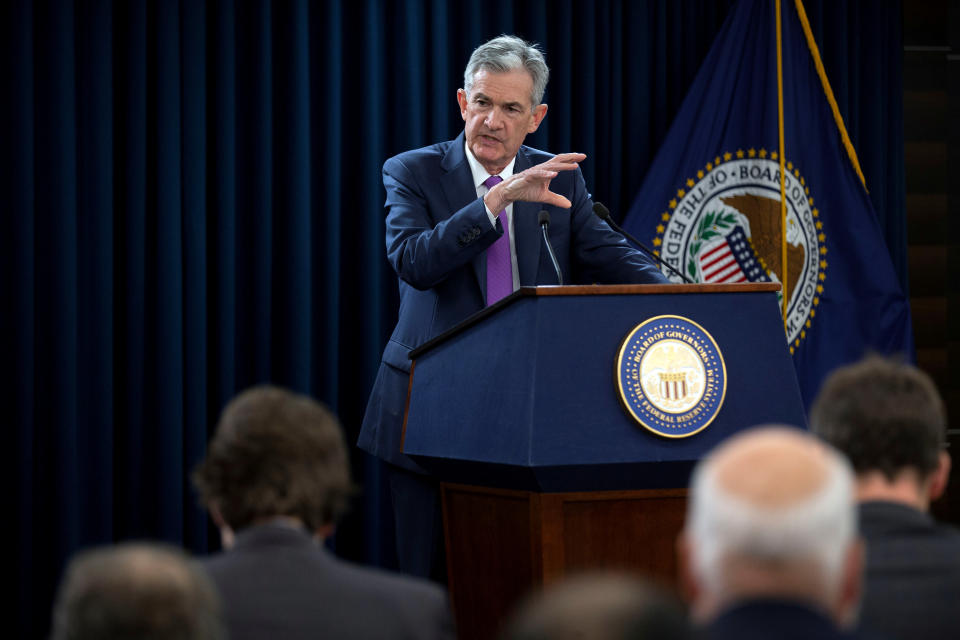The Treasury yield curve just inverted, sounding the alarm for recession
The bond market is beginning to sound the alarm of a recession, with an inversion in U.S. Treasury yields occurring on Monday for the first time since 2007.

The yield on the 5-year Treasury note fell below the yield on the 3-year note, meaning that investors were being paid more to hold U.S. government debt maturing in three years than comparable bonds maturing in five years. It’s not the major curve inversion that investors watch for — the 2-year note holding a higher yield than the 10-year note, which has preceded every U.S. recession since World War II — but it portends that the market is headed in that direction, analysts told Yahoo Finance.
Ian Lyngen, head of united rates strategy at BMO Capital Markets, said the inversion of 3- and 5-year yields has strengthened his belief that an inversion of the 2-year and 10-year yield will happen in late 2018 or early 2019.
“This solidifies not only my flattening bias but I think it will lead many players in the market who [expected the yield curve to steepen] to capitulate on that,” Lyngen said.
U.S. Treasury yields rose early on Monday after a deal between the U.S. and China to hold off on new tariffs. Shorter-dated yields rose faster than longer-dated yields, pushing the curve to invert between the 3- and 5-year yield.
The yield curve inverted between the 2- and 10-year yield before the recessions of 1981, 1991, 2000 and 2008. It has preceded all nine U.S. recessions since 1955, with a lag time ranging from six months to two years.
Analysts have pointed out that although many associate a yield curve inversion with recession, the phenomenon is a reflection of the kind of economic conditions that predict a market bust rather than being the cause of them.
An inverted yield curve is a sign investors think the government is less likely to pay back debt it owes in two years than what it owes in a decade — or in this case, the government is less likely to pay in three years than it is in five. Market analysts have pointed to everything from the increase in U.S. debt to cyclical factors like the market running out of steam as reasons for a downturn.
The combination of higher bond yields and the looming threat of recession is adding to fears about slowing global growth, investors said. It could also have implications for the Federal Reserve’s interest rate policy.
Fed Chair Jerome Powell said in a speech last week that U.S. interest rates were now “just below” the level that could be considered neutral and signaled that the Fed would stop raising rates. Investors viewed that as a stark turnaround from his remarks in October that the central bank was “a long way from neutral.”
Cameron Crise, macro strategist at Bloomberg LP, called the inversion “potentially the first shoe to drop in the end of the rate cycle.”
“Mind you, there can be a long delay between the first inversion of the curve and subsequent rate cuts, as the last cycle showed,” Crise said in a report for Bloomberg. “Still, it’s more evidence that we’re in the ‘late 2005’ analogue of the current Fed campaign.”
Fed officials have not spoken much about the possibility of a yield curve inversion, but earlier this year a number of members of the Fed’s rate-setting committee said it was a development they were watching.
“One of the most pervasive relationships in macroeconomics is that between the term spread — the difference between long-term and short-term interest rates — and future economic activity,” the San Francisco Fed’s Michael D. Bauer and Thomas M. Mertens wrote in March.
Atlanta Fed President Raphael Bostic even said in May that it was his job to prevent the curve from inverting, joining a number of other U.S. central bank bosses who had openly voiced concern about inversion.
—
Dion Rabouin is a global markets reporter for Yahoo Finance. Follow him on Twitter: @DionRabouin.
Follow Yahoo Finance on Facebook, Twitter, Instagram, and LinkedIn.
See also:
Wall Street managers have cost Americans more than $600 billion over the past decade
It’s the end of the world as we know it, and investors feel bullish
The dollar’s status as the world’s funding currency is in question
The stock market is at ‘a crossroads’ and on course for a ‘reckoning’ in 2019, investors say
Follow Yahoo Finance on Twitter, Facebook, Instagram, Flipboard, LinkedIn, and reddit.
